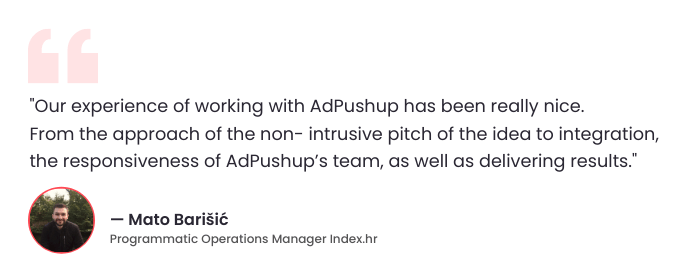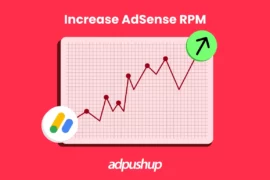WordPress powers 35% of all sites across the web. Some of those sites include CNN, TechCrunch, Forbes, and many other popular sites. And over 2 million publishers monetize using AdSense. Using a WordPress site with AdSense brings together the two most powerful tools available for web publishers.
Next, WordPress supports more than 54,000 plugins to help publishers with various design and utility related tweaks. Likewise, you can find many of those helping with inventory monetization.
How to add Google AdSense to your WordPress site –
WPBeginner wrote a brilliant and easily understandable post on how to integrate AdSense with WordPress. Here’s a two-minute video to get you started.
Tips to make your AdSense perform better than your expectations
1. Maximum no. of allowed Ad units – I’ll start off with a basic one: AdSense allows you have up to three standard ad units on a page, so it will be prudent to take advantage by maxing out the no. of ad units.
2. Be wary of Link units – This point is worth repeating. Although many publishers focus primarily on traditional ad units, link units have the potential to out-earn leader-boards and rectangles.
3. Maximum no. of Link units – Link units are a grossly underestimated AdSense option; placing up to three of these on a single page will give you a quick, meaningful boost.
4. Enable placement targeting – This enables advertisers to include your website in their display campaign, either by name or by targeting a user interest group. Placement targeting should be enabled by default because it helps in landing more targeted ads.
5. Set up a CSE (Custom Search Engine) – This is another useful way to get more AdSense units on your site; custom search engines will generally see very high RPMs (though traffic is relatively light). RPM (revenue per thousand pageviews).
6. Use standard units mostly – While AdSense lets you choose from more than a dozen ad units, there are a few units that are more common with advertisers. Implementing these tried and tested ad sizes–300×250, 728×90, and 160×600–will give AdSense a deeper pool of advertisers from which to pick.
7. Set up custom channels – Setting up custom channels will allow you to get better insights into what’s working and what isn’t, and will make future testing easier. It’s pretty easy to get these up and running, and worth making the up-time investment to do so.
8. Allow text & images types – One of the primary choices within AdSense involves either restricting an advert to “image only” or allowing both text and image ads. Permitting text ads placements gives AdSense a deeper pool of ads, and will almost certainly boost your click through rate and earnings.
9. Monitor fill rate – Make sure that you’re serving ads and not blank white space on your site. Monitoring fill rate is an easy method to ensure you’re not losing any revenue to empty spots.
10. Place units Above the Fold – This one might seem obvious: the higher up on a page your ads are, the more they’ll be viewed (and the more you’ll earn). However, this could be a trade-off between UX and your earnings.
11. Related positioning matters. While placing ads above the fold is usually advantageous, the related positioning of ads (i.e., what they’re next to) is more important than their explicit location in the page.
12. Supplement AdSense – AdSense policy allows for only three ad units per page. In most cases, pages can comfortably accommodate more than three ads per page without overpowering visitors and leading to a messed up user experience. If you think your site could use more ad units, there’s nothing to stop you from complementing your AdSense units with ads from a competing ad networks.
13. Beware of ‘ad overdose’. When pursuing AdSense earnings, it’s easy to get carried away and make decisions that are detrimental to the user experience in order to generate more income. While this may be a short term win, you’ll ultimately hurt the long term earnings potential of your site by decreasing your traffic numbers. Here is the example Google gives of what not to do (right side):
14. Monitor your In-Dashboard health – Within AdSense partners will see a “scorecard” widget that shows their revenue optimization score. This tool is pretty generic, but it’s worth confirming you have the highest possible score there.
15. Drag out loading speed of ads – Slow loading ads pull down not only the performance of your AdSense, but of your overall site. With smaller attention spans, this is critical to the traffic and user experience of your site.
16. Optimize ads for mobile traffic – The percentage of your traffic coming from mobile devices is probably larger than you suspect, and it’s growing quickly. Check out the advert experience for your mobile visitors; if it’s sub-standard, there may be page elements and ads that need to be replaced.
17. Place top performing Ad units first in HTML – Since ads are served on a first come, first served basis by AdSense, showing your top performing adverts first in the HTML will ensure that they get the best ad available which will boost CTR.
18. Understand “Statistical Significance.” – When you run experiments, it’s important to avoid jumping to conclusions based on insufficient data. Create a sample, run tests and then make decisions based on the results. This will make for more targeted guessing and revenue boost.
19. Get comfortable with AdSense Reporting – AdSense features an extremely detailed, flexible and user-friendly reporting interface. Making sense out of the available data will help you become better at optimizing AdSense operations.
20. Do not put up misleading Ads – As a rule of thumb, your ad units should not be deceptive. They should always be clear to visitors that ads are ads. If you give the impression that users are clicking on a different section of your site then you’re misleading them and may be subject to penalty by Google.
5 WordPress AdSense plugins to help you increase revenue from your ads

Ad Injection
Ad Injection enables you to insert adverts anywhere around the existing content of websites hosted on WordPress. The adverts can be from any of the popular ad networks like Google AdSense, ClickBank, Amazon Associates and TradeDoubler among others.
Ad Injection allows ads to be placed above, middle or bottom of the fold and even on sidebars/widgets. It also gives you control on the number of adverts that can be on a page. You can A/B test advert spots to see which one is performing better by getting higher CTR.
The first and most drawback that I could find with this plugin is that it is too powerful and therefore caters mostly to advanced users.
Ad Rotate
Ad Rotate manages to impress new users right with its friendly interface. Its engaging dashboard helps in quickly adding single or multiple ads on your website.
The Geo-location option helps in controlling ads and helps in making for more precise user targeting.
It also features access to basic analytics which show information on which ads are performing well/bad on a daily/monthly basis. The plugin also enables tracking banner clicks and the resulting click through ratio.
The only drawback is that the free version comes with more-than-necessary disabled options which almost makes its functionality quite restricted and almost useless. I understand that developers have to make a living too but some options concerning planning and reporting should be allowed to make the plugin more controllable and productive.
Simple Ads Manager
Simple Ads Manager is another ad rotation and optimization plugin popular in the wordpress directory right now. Once the weight of each advert space is determined by constructing groups, the plugin then rotates ads with a predefined and flexible logic – meaning it is automatic but you can change the placements to suit your needs. The rationale is to show ads that perform, chosen either by the plugin or which have been customized to perform by the user.
It supports HTML, javascript, PHP ad codes and the ‘Ad Zone Selector’ feature allows users to drag and select advert spots in the webpage. For beginners who don’t know where to start; don’t worry because the plugin provides default ad places. The dashboard is user friendly and yet it provides complex functions for seasoned users. Bonus feature: It supports codes for Google DoubleClick for Publishers (DFP).
Quick AdSense
From all the plugins mentioned before, Quick AdSense leads when it comes to download numbers. It has a very simple interface which helps you inject ads into the page immediately with no complex settings. Simply put – the plugin randomly places ads across your site with the rationale being that this will catch user attention and help fight banner blindness.
The author does not have any share in your AdSense revenue, so no need to worry about revenue loss. Other features include default ad positions, fixed/random ad positioning, display ads upto 10 in number and simple configuration with no requirement of coding skills.
It’s the plugin’s simplicity and ease of use that makes it so popular.
Advanced Ads
Thomas Maier says that he decided to write his own WordPress plugin to manage and optimize his ads independently of what the market had to offer. Before that, he used plugins which were either outdated or not meant to increase the revenue from AdSense. So he decided to create Advanced Ads.
It is a tool made by publisher for other publishers who have faced same issues as him. A brilliant feature that differentiates it from the competition is the user friendly ad optimization & testing option. Other features include multiple ad networks, ad rotation and checking ad conditions (how each ad is performing on a web page).
Definitely a tool worthy of a try because of the powerful yet light weight ad management solution.
Bonus: AdPushup
AdPushup is an ad revenue optimization tool which can help web publishers make more money from their existing website traffic using advanced automated A/B testing without the need for any programming knowledge.
Finally, let me know if you have any useful (and essential) tips that I might have missed out on.

Shubham is a digital marketer with rich experience working in the advertisement technology industry. He has vast experience in the programmatic industry, driving business strategy and scaling functions including but not limited to growth and marketing, Operations, process optimization, and Sales.



![18 Actionable Tips to Increase Adsense Revenue + [Bonus Tips for Video Ads] Google adsense revenue](https://www.adpushup.com/blog/wp-content/uploads/2023/06/featured-image_01-1-270x180.png)



